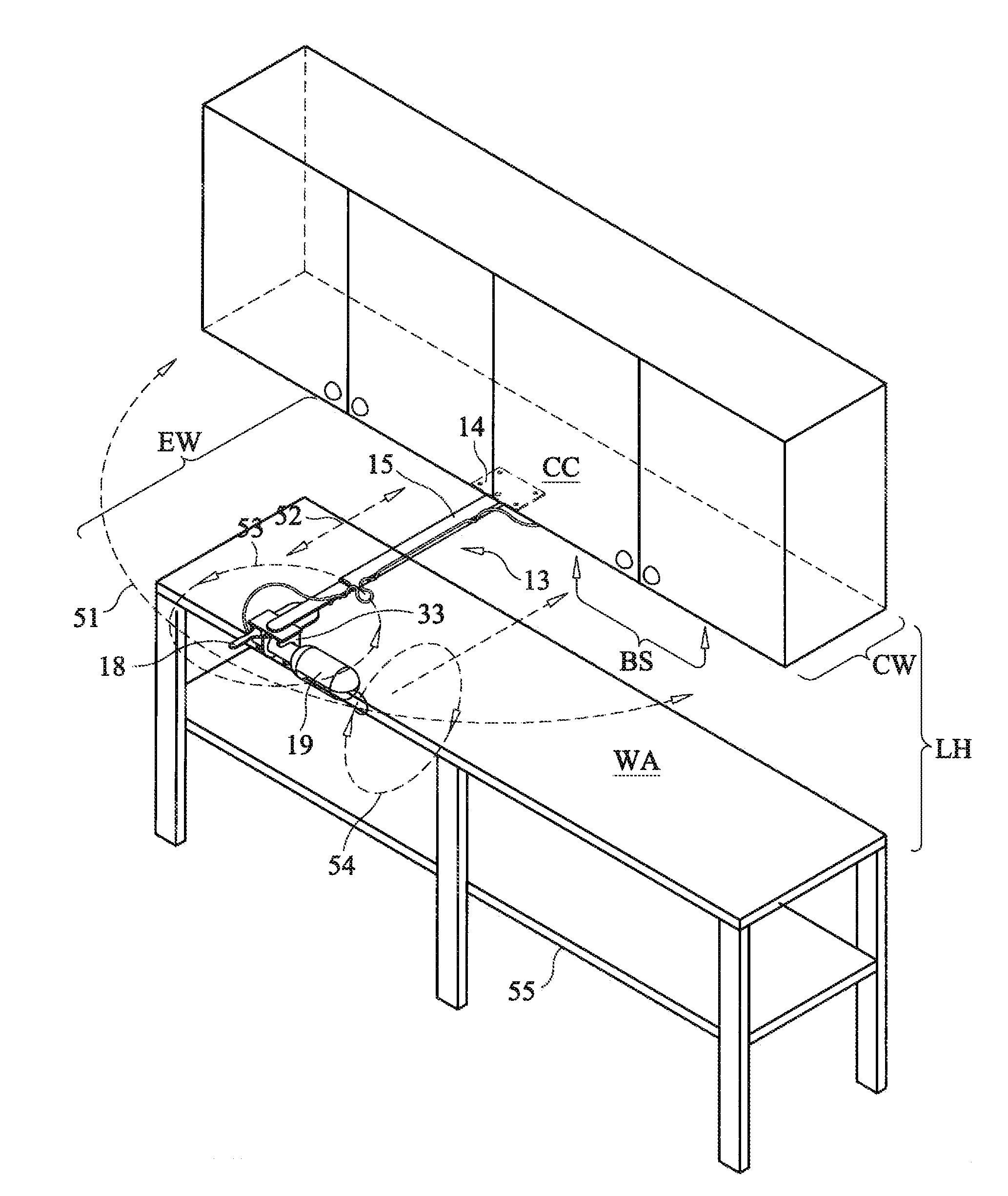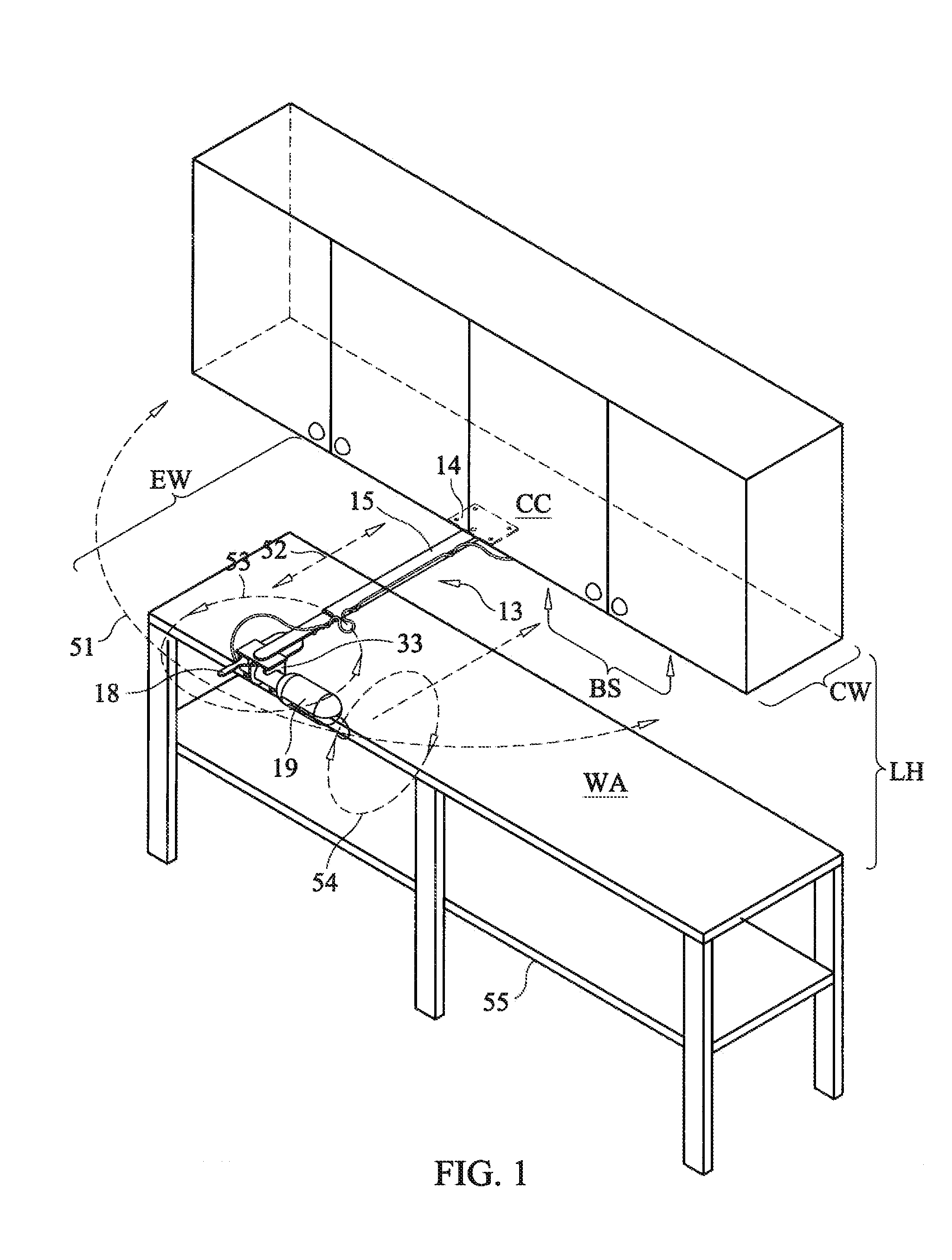Such work spaces are frequently located in garages and basements, however, and are therefore often dimly lit.
The distance from a source of light in the center of the room to a work bench against one of the room's walls may result in decreased intensity of light, which may make it difficult for a handyman to reliably and quickly discern objects and details on the work bench.
Moreover, since a handyman is often positioned at least partially in between the work benches and the
light fixture, the silhouette of the handyman may often obstruct to some degree the source of light from shining directly on the work bench, thereby
casting shadows over the work bench.
Installing permanent light fixtures over or near the
work space to provide additional light is not always possible or desirable, since such an installation normally requires running electrical wire though walls to reach a potentially remote part of a room.
Suffice it to say that the costs and tedium involved with installing such permanent light fixtures over or around work benches often outweigh the benefits.
Even when such permanent light fixtures are installed closer to a work bench, cabinets and / or shelves and / or studs that may hang directly over or nearby the work bench, and / or other geometrical objects, may still cast shadows.
Furthermore, even when such a
light fixture is installed underneath such a cabinet, shelf, or stud, or on the wall next to the work bench, so that the light shines more directly onto the work bench, work benches are often large and cover more than just the limited area beneath such a light.
Thus, the newly installed light may not adequately shine a sufficient amount of light on certain other areas of the work bench to allow the handyman to perform the desired manual tasks.
Fixed lights that are elongated tubes might run a greater portion of the length of a work bench but installation of such lights still involves the above-mentioned problems and disadvantages associated with installing fixed lights generally.
Moreover, said long tube lights and the housing thereof may be bulky and take up substantial space in order to provide sufficient light for the entire length of the work bench.
In addition, as with fixed lights generally, such tube lights may either shine light directly into the handyman's eyes or may cast shadows over the work bench due to the handyman's silhouette or other objects.
The problems associated with fixed lighting sources have resulted in a variety of alternative, semi-portable lighting systems, such as lamps, trouble lights, etc.
Specifically as it relates to attempts to provide adequate light for a
work space, such often-portable lighting systems share many of the same disadvantages as fixed lights.
For example, it is difficult to position such portable lights to not cast shadows over the work space, without shining light into a handyman's eyes, and also difficult to quickly and easily position the
light source to shine light directly on one particular area of a work space and then reposition the
light source to shine directly on another separate area of the work space.
These difficulties arise partly from the fact that lamps usually have bases designed to lie on the ground, and thus must be positioned away from the work bench.
Such lamp bases, moreover, take up floor space and often incorporate tripod and other designs that are not sufficiently sturdy to remain intact after inadvertently coming into contact with other objects or persons.
Desk lamps, furthermore, have bases that take up space on a work bench and often leave electrical cords loosely
lying on the work bench.
In addition, many such lamps, as well as prior art light holders, are not able to be stored compactly when not in use.
Some such lamps do have telescopic members designed to allow the total size of the lamp to be minimized, but these generally compact primarily along the vertical axes.
Furthermore, any prior art lighting device that may have a member that retracts and extends along a
horizontal axis to allow light to shine directly on objects on a work bench located away from the base of the lamp is unlikely to allow a handyman's eyes to be shielded from direct light emanating from the
light source.
Rather than using lamps or certain other lighting devices in areas that do not receive adequate illumination from fixed lighting, many handymen often use and attempt to use trouble lights in work spaces.
However, it is not easy to quickly position such trouble lights so that they shine light on a particular area of a work bench where illumination is desired at a given moment, and then on another work bench area in another moment.
Even when a desired trouble light position is achieved, the trouble light might be unstable so that even the inadvertent bump might change the direction of the light.
Furthermore, resting such trouble lights on a work bench takes up valuable space and potentially leaves electrical wire or cord free and exposed on the work bench.
On the other hand, hanging such lights on hooks in a wall may either shine light into the handyman's eyes and / or also cast shadows on the work space.
Some prior art trouble light holders not may secure trouble lights in a sufficiently stable position while still allowing adjustment in order to shine light in a particular area or areas of a work bench.
In part this may be due to the difficulties of grabbing conical objects like trouble lights.
Even when a trouble light holder may securely grab a trouble light, furthermore, the holder may not allow the trouble light to radially spin to further direct the light, while staying in a secure position.
Moreover, although some devices may utilize clamp-like features to attach a light source such as a trouble light to a particular surface or object, few devices utilize a clamping mechanism to actually securely hold and release a trouble light, which may then be positioned and repositioned in various coordinates of a horizontal plane to provide adequate illumination to the work space.
Furthermore, no prior art device attempts to accomplish all this while mounted under a vertically positioned object having a flat bottom surface, thus freeing up space on the work bench.
 Login to View More
Login to View More  Login to View More
Login to View More 


